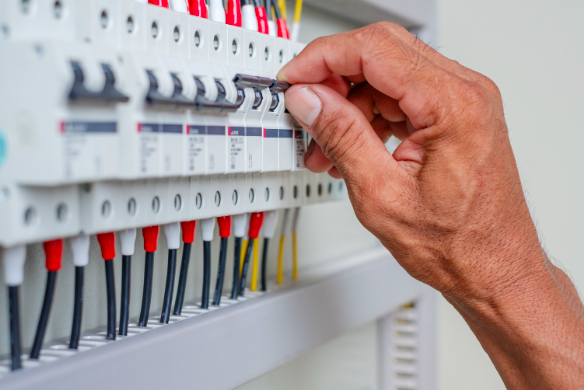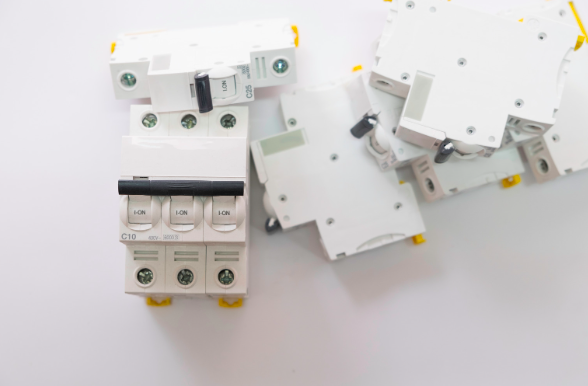Last Updated on November 25, 2022 by mdmtool
Relays and circuit breakers are two essential components in any electrical system. They both serve to protect equipment and people from potential hazards, but they each have their own unique set of features.
What Is A Relay?

A relay is a switch that uses an electromagnet to open or close the circuit. The current flowing through the coil of the electromagnet activates the electromagnet, which in turn closes (or opens) the switch. They are often used to control high-voltage circuits with low-voltage signals.
Relays can be used to control either AC or DC circuits. Relays are available in a variety of sizes and shapes. Relays can be either manually or automatically operated.
What Is A Circuit Breaker?

A circuit breaker is an automatic switch that turns off the power to a circuit when it detects an overload or short. They are designed to protect circuits from damage caused by excessive current. Circuit breakers are only used to control AC circuits. They are always automatically operated and standardized in size and shape.
Difference Between Relay And Circuit Breaker

- Open And Close The Circuit: A circuit breaker is that a relay uses an electromagnet to open or close a circuit. In contrast, a circuit breaker uses a thermal or magnetic element to open or close a circuit.
- Power Voltage Input: The main difference between a relay and a circuit breaker is the power voltage input. A relay requires a relatively low power voltage, while a circuit breaker can handle much higher voltages.
- Power Usage: A relay can be used in lower-power applications, such as controlling small motors or lights. At the same time, a circuit breaker is better suited for higher-power applications, such as electrical distribution.
- Contact Breaking: Circuit breakers have moving contacts that separate to open the circuit. Relays also have contacts, but they do not move. The switch is either on or off. When a circuit breaker opens, it physically disconnects the current path. This protects the electrical system from damage caused by an overload or a short circuit. On the other hand, a relay does not physically disconnect the current path when it opens.
- Operated: The main difference between a relay and a circuit breaker is that a circuit breaker can be manually operated while a relay cannot.

Types Of Rely
There are two types of relays:
- Electromechanical Relay: An electromechanical relay (EMR) is an electromagnetic switch operated by an electromagnet to open or close the circuit. It has a low coil resistance and requires little power to operate.
- Solid-State Relay: A solid-state relay (SSR) is a switching device that uses semiconductors such as diodes, transistors, and thyristors to open or close the circuit. It has a high coil resistance and can handle large amounts of power.
Types Of Circuit Breakers
Circuit breakers come in two main types:.
- Thermal: Thermal circuit breakers are the most common type, and they work by using a bimetallic strip that expands when heated. The expansion of the strip causes the contacts to open, which breaks the circuit.
- Magnetic: Magnetic circuit breakers use an electromagnet to open the connections. These types of circuit breakers are often used in industrial applications.
FAQs
Can We Use A Relay As A Circuit Breaker?
No, we cannot use a relay as a circuit breaker because the two devices serve different purposes. A circuit breaker is used to interrupt the current flow in an electrical circuit, while a relay is used to control the current flow.
Why Is The Relay Required With Circuit Breaker?
A circuit breaker protects an electrical circuit from damage caused by an overload or short circuit. A relay controls the flow of current in an electrical circuit. The relay is required with the circuit breaker because it helps prevent damage to the electrical circuit by controlling the current flow.
What Is The Auxiliary Relay With A Circuit Breaker?
An auxiliary relay is a device with a circuit breaker to provide additional protection for the electrical circuit. The auxiliary relay helps detect faults and then trips the circuit breaker to interrupt the current flow.
Why Don’t We Use Relays To Trip A Circuit?
Relays are not designed to trip a circuit. They are designed to control the flow of current in an electrical circuit. Circuit breakers are designed to interrupt current flow in an electrical circuit.
Do The Relay And Circuit Breaker Connect?
No, the relay and circuit breaker does not connect. They are two separate devices that serve different purposes.
Conclusion
Relay and circuit breakers are two essential components in an electrical system. Though both are used to protect electrical circuits from overload, they function in different ways. A circuit breaker interrupts the current flow in an electrical circuit, while a relay controls the current flow. Relays are required with circuit breakers to provide additional protection for the electrical circuit.





